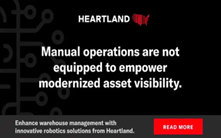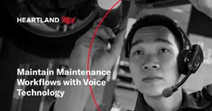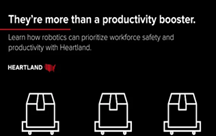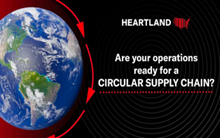
11 Reasons Your Workflows Need an IoT Solution
Mar 21, 2024
The Internet of Things (IoT) has transformed supply chain management with unprecedented visibility into every aspect of the enterprise. IoT refers to a connected network of devices, equipment, vehicles, and other items with embedded sensors, software, or other technology. These sensors communicate with each other by transmitting data via a wired (e.g., ethernet) or wireless network. IoT devices include smartphones, motion sensor lights, GPS trackers, voice-enabled controllers (Google Home, Amazon Echo), robotic vacuum cleaners, heart monitors, activity trackers, and RFID tags in merchandise.
For IoT devices to connect with each other, you need an IoT platform, the foundation of your IoT ecosystem. This platform allows you to manage your assets. With your network of devices constantly expanding, your network must be scalable and sustainable. If you’re not yet utilizing its transformative powers, Heartland has 11 reasons your workflows need an IoT solution.
- Leverage visibility across the supply chain - Every sensor within your enterprise gathers data according to its programming and automatically transmits the information, with no human intervention. Manufacturing updates, equipment maintenance schedules, order processing, vehicle movement, inventory reports, quality control, asset locators, energy controls, and safety hazards are just a few of the types of data that can be gathered and shared via IoT. With the volume of reliable, real-time insights available, management can confidently make quick decisions that are based on data, not guesses and interpretation.

RELATED: REDUCE THE IMPACT OF LABOR SHORTAGES AND BOOST WAREHOUSE VISIBILITY.
- Maximize fleet efficiency - Use the sensors in your vehicles for fleet management, to monitor location, track fuel consumption, optimize routes, and ensure DOT compliance. Stay ahead of routine maintenance and receive alerts when the vehicle is experiencing mechanical problems to prevent breakdowns that not only incur the expense of repairs but also the cost of delays. Your IoT solution can include tracking of the driver’s behavior and patterns, ensuring their safety. If there’s an accident, the IoT sensors automatically send an alert.

Related: Do you have the same struggles as today’s top fleet companies?
- Track assets in real time - Your business relies on its assets. Whether those are inventory, equipment, supplies, vehicles, or people, you need to know where they are and, with the exception of your workforce, the condition of these assets. Asset tracking technology, like RFID, sends notifications about any deviations from the planned routine, like misplaced inventory, communicating directly with your Enterprise Asset Management system. IoT provides this essential asset tracking information, so your investment is protected.

Related: Redefine inventory tracking in the Age of Diversification.
- Prevent equipment failure and downtime - Manage your machinery to avoid breakdown and failures. Use your IoT device algorithms to monitor maintenance schedules and equipment status. When the sensor detects a problem, you receive an alert—so you can preemptively respond, rather than react to a situation like unexpected downtime.

Related: How to Enhance Maintenance Workflows with Voice Technology
- Monitor workflow productivity - Operational efficiency is critical to profitability. IoT devices, like wearables and wristbands, provide insight on the efficiency of your processes and workers. Get actionable data to find bottlenecks in your supply and unblock them. You can also see workers who excel in their tasks and reward their valuable productivity. This, in turn, motivates them to monitor their own performance analytics.

RELATED: 3 REASONS WHY YOU SHOULD REEVALUATE YOUR CONNECTIVITY INFRASTRUCTURE - Protect workers - Deploying autonomous mobile robots (AMRs) can improve productivity while also preventing workers from moving in and out of restricted or hazardous areas. Use IoT-enabled technology to alert you to situations that present possible risk. In addition, if your workers are handling hazardous materials, working in extreme climates (like cold storage) or where vehicles are operated, motion sensors can provide alerts to any risks to their safety.

Related: Robotics and Worker Safety Go Together. Here’s why:
- Reduce damage and spoilage - Use IoT devices to report fluctuations that could lead to spoilage, such as temperatures in cold storage or vehicles transporting perishables and temperature-sensitive assets. Sensors track the temperature, humidity level, and any other parameters needed to prevent damage and spoilage, another money-saving advantage to IoT in the supply chain.

RELATED: REDUCE YOUR CARBON FOOTPRINT WITH A CIRCULAR SUPPLY CHAIN
- Streamline the flow of goods - The use of IoT-enabled technology provides real-time analytics on your inventory. From Receiving to Shipping, every movement is tracked. There are no more blind spots! You have an up-to-date digital record that shows the flow of materials throughout your supply chain—with product information, quantity, and time stamp. With AI, you can find ways to improve those processes. Fixed RFID readers capture product information from a distance, eliminating the need to scan the RFID tags manually. Your workers no longer waste time searching for misplaced inventory, and you avoid the cost of replacing lost assets.

Related: Why managing a warehouse with RFID tracking is easier
- Increase accuracy - Manual processes lead to human error, which is the major cause for losses in the supply chain. Such IoT-enabled technology as voice-picking , provides fast and accurate order picking. Cycle counts using voice-directed solutions are faster and more precise than manual inventory counts. With a verifiable view of your inventory, you can manage levels that support a healthy bottom line.

Related: Explore 8 places where hands-free technology thrives in the supply chain.
- Simplify and centralize facilities management - Warehouses, manufacturing facilities, and distribution centers are massive spaces that encompass a broad array of individual functions and business centers. Managing one facility is challenging enough, but if you’re coordinating the operations of multiple locations, you need the centralized facilities management solution that IoT devices and platforms deliver. In one dashboard, you can view every function in your enterprise. Track the movement between them, compare metrics, and use this centralized perspective to make smart decisions that save time and money.

- Support sustainability and conserve energy - If you have a smart thermostat at home, you already know that an IoT device can conserve energy. Imagine this technology in the vastness of your supply chain operation as a sustainability measure. Establish parameters to control energy use, like electricity and water consumption. Monitor temperature and humidity levels. You’ll be alerted when anything deviates from those presets. Occupancy sensors conserve energy by turning lighting on and off in certain spaces as needed. The same smart technology can be integrated with your HVAC system, monitoring use and preventing waste. If your facility employs alternative energy sources, like solar and wind, use your IoT-enabled systems to manage their effectiveness. You can also access the reports to support compliance and money-saving initiatives through tax deductions. Use the data to identify inefficiencies, so, like every other area in your supply chain, you can make the right decisions to benefit your overall operation.

These 11 reasons your workflow needs an IoT solution is just a start. Heartland’s expertise in the areas of manufacturing, distribution, and logistics allows you to source the right approach to your challenges. Our scalable approach to building solutions, like IoT, integrates the hardware and software—including comprehensive training and unmatched support—that fits your objectives and budget. And as an award-winning Honeywell partner, Heartland is on top of the most advanced technology that delivers maximum ROI. Contact Heartland to explore the management potential of IoT in your enterprise.


